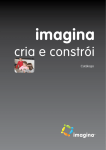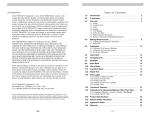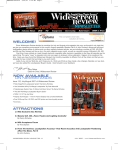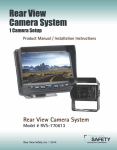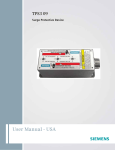Download User's Manual - Directional Audio
Transcript
20,1, 18,3, 16,5, 14,7, 12,9 2,19, 4,17, 6,15, 8,13, 10,11 20,1,2,19,18,3,4,17,16,5,6,15,14,7,8,13,12,9,10,11 ® ® User’s Manual © 2010 Holosonic Research Labs, Inc. Audio Spotlight® User’s Manual 3 Introduction "... Audio Spotlights may be the most radical technological development in acoustics since the coil loudspeaker was invented in 1925... The audio spotlight will force people to rethink their relationship with sound, as the arrivals of the phonograph, the telephone and the Walkman have done before." - New York Times Thank you very much for choosing the Audio Spotlight system. Years ago as a MIT graduate student, I created the Audio Spotlight because of deficiencies I saw in the way traditional loudspeakers made sound – in particular, their lack of control. Never before has it been possible to give people the power to control not only what their sound is, but also where their sound goes – and where it doesn’t. I founded Holosonics to commercialize the Audio Spotlight technology, and make it available to anyone who would like to take advantage of its unique features. As we move forward, I would like to hear from you, regarding your experiences, successes, challenges and ideas regarding the Audio Spotlight technology. I and everyone at Holosonics look forward to working with you. Dr. F. Joseph Pompei President and Founder 4 Audio Spotlight® User’s Manual Important Safety Instructions 1) Read these instructions. 2) Keep these instructions. 3) Heed all warnings. 4) Follow all instructions. 5) Do not use this apparatus near water. 6) Clean only with dry cloth. 7) Do not block any ventilation openings. Install in accordance with the manufacturer’s instructions. 8) Do not install near any heat sources such as radiators, heat registers, stoves, or other apparatus (including amplifiers) that produce heat. 9) Do not defeat the safety purpose of the polarized or grounding-type plug. A polarized plug has two blades with one wider than the other. A grounding type plug has two blades and a third grounding prong. The wide blade or the third prong is provided for your safety. If the provided plug does not fit into your outlet, consult an electrician for replacement of the obsolete outlet. 10) Protect the power cord from being walked on or pinched particularly at plugs, convenience receptacles, and the point where they exit from the apparatus. 11) Only use attachments/accessories specified by the manufacturer. 12) Use only with the cart, stand, tripod, bracket, or table specified by the manufacturer, or sold with the apparatus. When a cart is used, use caution when moving the cart/apparatus combination to avoid injury from tip-over. 13) Unplug this apparatus during lightning storms or when unused for long periods of time. 14) Refer all servicing to qualified service personnel. Servicing is required when the apparatus has been damaged in any way, such as power-supply cord or plug is damaged, liquid has been spilled or objects have fallen into the apparatus, the apparatus has been exposed to rain or moisture, does not operate normally, or has been dropped. 15) Installers are required to follow sound and reasonable judgment when installing Audio Spotlight products. Compliance with all building, safety, and fire codes is the sole responsibility of the installer and/or end user. 16) Do not connect Audio Spotlight® devices to traditional loudspeaker amplifiers or loudspeakers. Damage and/or hazardous conditions could result. 17) Our standard cables are not plenum rated. Please contact the factory if special specifications are required. WARNING: To reduce the risk of fire or electric shock, do not expose this apparatus to rain or moisture. are hazardous live. External WARNING: Terminals marked with the symbol wiring connected to these terminals requires installation by a qualified, instructed person or the use of ready-made leads or cords. WARNING: When mounting the speaker panel overhead, always use a secondary fastening method in case the primary attachment fails. Audio Spotlight® is a registered trademark of Holosonic Research Labs, Inc. US and International patents issued and pending. The symbol indicates that there are hazardous voltages within the enclosure. Do not open. Refer all servicing needs to the manufacturer, or the manufacturer’s designated service representatives. Audio Spotlight® User’s Manual 5 Package Contents 6 Audio Spotlight® User’s Manual Controls Audio Spotlight® speaker panel SoundBeam® controller Speaker Cable (25’) Power Supply, Power cable Eyebolt (6-32) Demonstration CD 1 Optional Accessories: MNT-1 Mounting Bracket MNT-2 Extended Mounting Bracket CM-1 Suspended Ceiling Mount Kit CM-2 Suspended Ceiling Mount Kit with Bracket 2 4 5 6 1. 2. 3. 4. 5. 6. Quick Setup Power indicator Volume control Auto-level Low freq control High freq control Level indicators 1 Power supply to wall outlet 3 Glows green when power is on Adjusts output level Allows system to automatically adjust level Adjust low-frequency cutoff Adjust high-frequency leveling First green: input signal detected Second green: output is being optimized (only with auto-level on) Red light: output is clipping Solitary red light: Fault detected 2 3 4 Audio source (CD player, etc. not included) Audio Spotlight® speaker panel Remember: Do not connect SoundBeam® controller to traditional loudspeakers and do not connect Audio Spotlight® speaker to traditional audio amplifiers. Equipment damage and/or hazardous conditions may occur. 1. 2. 3. 4. Power switch Power input Output connector Audio Input Press to turn on, press again to turn off Receives power from included DC supply Connects to speaker panel via included cable RCA jack for standard line-level audio input (mono input should use Red input) Audio Spotlight® User’s Manual 7 8 Audio Spotlight® User’s Manual Operation Speaker Mounting 1. 2. 3. 4. The speaker panel was designed for flexible mounting. There are two sets of mounting holes: the center contains two ¼-20 threaded inserts, and around the perimeter are four 6-32 threaded inserts. The hole pattern (see Appendix A) is fairly standard, and is compatible with many standard speaker mounts. 5. 6. 7. 8. Be sure system is connected as shown in “Quick Setup” Turn the volume knob down (counterclockwise). Turn the system power on using the power switch. Start your audio source (such as CD player). If a signal is received, the first green light should illuminate. Increase volume until two green lights are illuminated. The system is playing at a nominal volume level. If volume is increased, eventually the red light will illuminate, indicating that the amplifier is clipping. Reduce volume slightly if this occurs. The system should now be playing music. Adjust equalizer knobs if necessary. Once the system is set up, it can be powered off and on without modifying the settings. This is useful when one power source (such as a power strip) is used to power several devices in an installation simultaneously. Wall / Ceiling Holosonics recommends using our own mounting kits (MNT-1) with ® Audio Spotlight speakers. The bracket easily attaches to the back of the speaker with two included screws, and can mount to any suitable flat surface. By loosening the screw on the bracket, the speaker panel can be aimed as desired. An extension arm is also included. See the instructions that come with the MNT-1 kit for more details. Auto Level: To assist the user in setting an optimal volume level, the auto-level feature can be enabled by sliding its switch to the right. The volume knob is used normally, but the enabled auto-level feature prevents clipping during unusually high input signals. Formally, the auto-level feature acts as a basic audio “compressor”, automatically reducing signal gain for high peak signal levels. It can be disabled by sliding the switch to the left. Fault Protection In order to protect itself, as well as other equipment in an installation, the Audio Spotlight is designed to detect the presence of one or more faults. When a fault is detected, the system shuts down, and the red light blinks alone. A fault is the result of one of three causes: • • • Disconnected or damaged speaker panel Overheating Overdrive If the system is driven substantially into the clipping region, the system will shut down to avoid poor sound output and possible damage. Once the system is checked, turning the system off for three seconds, and then on again, will reset the fault. ! CAUTION When hanging any system overhead, a backup safety line must be used. A 6-32 eyebolt is included for this purpose. Screw the eyebolt into one of the four perimeter holes, and secure independently with a strong line. Be sure that the ceiling structure can support the weight of the device reliably without warping or bending Overhead cable hanging Overhead cable hanging is useful when shining the Audio Spotlight beam straight down, particularly from a high ceiling. Use four 6-32 eyebolts to suspend the speaker panel from steel cable. Eyebolts are commonly available, and Holosonics can supply them upon request. Audio Spotlight® User’s Manual 9 10 Audio Spotlight® User’s Manual Suspended ceilings Optimizing your sound Suspended ceilings are not designed to support heavy loads. When hanging an object from a suspended ceiling, be sure that it is connected to the structural ceiling. The Audio Spotlight uses a carefully crafted ultrasonic beam to create a ‘virtual source’ out of the air itself. The system is technically called an airborne parametric array, named after similar techniques used in underwater sonar systems as early as the 1960’s. Flush mounting: The thin profile of the Audio Spotlight speakers makes flush mounting attractive and simple. Our CM-1 flushmount kit contains a support brace for using inside the ceiling grid, and two long screws for attaching the speaker. Be sure to use hanging wire to attach the support brace to the structural ceiling. For aiming: Our CM-2 kit combines the CM-1 kit with the MNT-1 mount, allowing flexible aiming of the speaker panel in a suspended ceiling. The MNT-1 attaches to the ceiling panel with two long screws, two washers, and two nuts. The screws extend up to the support brace and connect with two more nuts. Inherent in the conversion from ultrasound to audio is a natural 12dB per octave slope, meaning that less ultrasound is needed to create high frequencies than low frequencies. This can be easily corrected with built-in equalization, but with a finite amount of energy available, a tradeoff exists between maximum output level and low frequency range, and high frequencies can be made maximally louder than low frequencies. The two knobs on the Controller unit permit this exchange to occur gracefully. The graph below shows the way sound is controlled with the Audio Spotlight. The thick line is the system’s approximate “natural” (i.e. uncorrected) response, and the dashed lines show various selected frequency ranges, adjusted with the high frequency selector knob. The dotted lines show the effects of changing the low-frequency cutoff, which is useful for not “using up” ultrasonic energy on low frequencies. Ceiling tile mounting: The AS-24 model is designed to precisely replace a standard 2’x2’ or 600mm ceiling tile. This allows for seamless integration in suspended ceiling applications. Be sure that the ceiling frame is sufficiently strong to safely support the weight of the speaker panel, and always use a backup line for safety. dB High Freq control Low Freq control Frequency (log) Additional options There are many other mounting options for your Audio Spotlight speaker. Please feel free to contact Holosonics for assistance. Audio Spotlight® User’s Manual 11 12 Audio Spotlight® User’s Manual Understanding the sound field Basic Installation The Audio Spotlight creates a very precise, well-controlled beam of sound with no sidelobes or other artifacts typical of loudspeakers. The most common use of the Audio Spotlight is to deliver sound to a specific, isolated area. Just as with lighting, the Audio Spotlight is best mounted directly above the listener, aimed downward (left). This provides maximum localization. The speaker panel can also be mounted on a wall, and angled downward, to reach the listener (right). Because sound is created in mid-air, and not by the speaker panel, sound actually gets louder with distance – up to about 1 or 2m, depending on frequency. Sound also diminishes with distance more slowly than a traditional loudspeaker, creating a more uniform field of sound. An illustration of the field from the 16” (or 18”) system is shown below. Three contours are shown, at the contours of –0dB, -6dB (50%), and – 20dB (10%). Additional data is shown in Appendix B. 0m 1m 2m The loudest sound area is directly in front of the speaker panel at a distance of 1-2m. Reasonable listening areas are within the green or purple zones. Sound levels outside the beam are down by over 90%. In all sound systems, audibility is determined by sound level received versus background noise levels. Therefore, the beam will be perceived as more narrow in the presence of background noise, as any scatter from a listener or floor will be inaudible. This is much like the difference in shining a flashlight in a completely dark room versus one with background lighting. Reflections While the beam generated by the Audio Spotlight system is very narrow, the beam will reflect from surfaces (and listeners) in your environment. To sound waves, solid surfaces are much like mirrors are to light. Therefore, to reduce reflections, an acoustically absorbing surface (such as carpet, padding, or curtains) should be used to ‘catch’ the beam and reduce the reflection. Generally, this is most important only in very quiet spaces, where there is little background noise to mask minor scattered energy. Also, like light, reflections can be used as projection of audible sound. By directing the beam against a surface, one can create very interesting “virtual loudspeaker” effects. The beam will generally maintain its directivity after projection, so it is best to ensure that the listener is in the path of the reflected beam. Audio Spotlight® User’s Manual 13 14 Audio Spotlight® User’s Manual Multiple systems Subwoofer Augmentation Multiple Audio Spotlights can be used to create a larger field of sound, or to increase the sound intensity in a given region. Just like visual spotlights, beams of sound can be aimed next to each other, to “shape” the sound field (left), or multiple speaker panels can be aimed to one position (right). Just as with light, sound from these systems will combine to increase output substantially. While a traditional subwoofer is, of course, not directional, it can nonetheless be used effectively to augment the low-frequency reproduction of the Audio Spotlight system. The human ear, and a listener’s attention, is most sensitive to frequencies between 600Hz and 2kHz. As long as the level of the subwoofer is not too loud, and is limited to reproducing only low frequencies, the slight rumble that exists outside of the Audio Spotlight beam is generally unnoticed. Connecting a subwoofer is straightforward. Use a standard splitter (or “Y”) cable to send the same line-level signal to the Audio Spotlight and the subwoofer system. Since this line level is not amplified, a powered subwoofer, or separate amplifier, is required. The subwoofer’s crossover frequency, if it is adjustable, should be selected to suit your listening material and background noise. For isolated bass reproduction, one may also use a tactile transducer, such as the Aura Bass Shaker or Clark models. Contact Holosonics if you need assistance or subwoofer recommendations. Speaker Connection Cables Many variations of these basic designs are possible – this manual is intended to act as a guide. In considering different ways to install the Audio Spotlight, keep the lighting analogy in mind. More often than not, Audio Spotlights should be thought of in lighting design terms, not in loudspeaker terms. Your Audio Spotlight system includes a coaxial cable selected for optimum performance. Because of the wide variety of cables available on the market, many may or may not meet our standards for performance, particularly at long lengths. We recommend that you do not use third-party connection cables. If you have specific cable requirements, such as special lengths or types, please contact Holosonics and we are happy to offer our assistance. NOTE: Our standard cables are not plenum rated. Please contact the factory if special specifications are required. Audio Spotlight® User’s Manual Appendix A: Speaker Panel drawings All speaker panels are approximately 0.5” (1cm) thick. AS-16 AS-24 15 16 Audio Spotlight® User’s Manual Audio Spotlight® User’s Manual 17 Appendix B: Sound Field Specifications Design Specifications: 18 Audio Spotlight® User’s Manual Raw measurements The plots below are actual raw field measurements of a typical Audio Spotlight system. The speaker panel is shown as a black rectangle centered at (0,0). The spatial dimensions (X,Y) are in meters, and sound levels are in dB SPL. 18” Speaker (16” speaker is similar) 24” Speaker In general, the AS-24 model provides twice the output power, an additional octave of low-frequency reproduction, and a slightly larger listening area. Sound fields shown for standard 1kHz tone. © 2003 Holosonics Audio Spotlight® User’s Manual 19 Limited Warranty Holosonics warrants that your Audio Spotlight system is free from defects in material and workmanship for a period of one (1) year after date of purchase. This warranty does not cover claims for damage caused by accident, misuse, neglect, alteration, outdoor use, disassembly, unauthorized repair, shipping, or modification. Holosonics’ liability is limited to the repair or replacement, at our option, of any defective product, and shall not include incidental or consequential damages of any kind. Warranty is void if serial number is defaced or removed. Service If your Audio Spotlight system needs service, please contact Holosonics for a return materials authorization (RMA) number. Received units will not be accepted without a valid RMA. Call us, or email [email protected] . Holosonic Research Labs, Inc. 400 Pleasant Street Watertown, MA 02472 USA Phone: Fax: Email: Web: 617-923-4000 617-507-3474 [email protected] www.holosonics.com © 2010 Holosonic Research Labs, Inc. (“Holosonics”) Audio Spotlight® and Holosonic® are registered trademarks of Holosonics. US and International Patents Apply v11d














